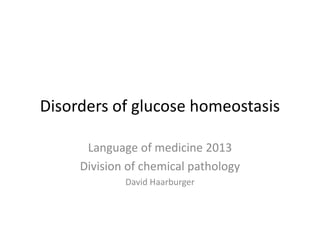Lom disordersofglucosehomeostasis2013
- 1. Disorders of glucose homeostasis Language of medicine 2013 Division of chemical pathology David Haarburger
- 2. Fuels Carbohydrates Fat (Polysaccharides) Proteins (Triacylglycerides) Fatty Acids Monosaccharide Amino acids Glycerol Glucose Ketones Glucose Ketones Glucose
- 3. Glucose • Major energy substrate • Essential for some tissues – Erythrocytes – Neurons • Can be oxidised to lactate or CO2 • Glucose concentration is tightly controlled between 2.5 and 8.0 mmol/L – Glycolysis – Glycogenolysis – Gluconeogenesis
- 4. Glucose and fat metabolism glucose glucose-6-phosphate phosphoenolpyruvate pyruvate lactate fatty acids acetyl-CoA + ketones oxaloacetate citric acid ATP
- 5. Metabolism during starvation triacylglycerides free fatty acids amino acids glucose ketones glycogen
- 6. Hormones involved in glucose control Glucose Glucose Counter-regulatory hormones Regulatory hormones • Glucagon • Insulin – Glycogenolysis – Gluconeogenesis – Glycogen synthesis • Adrenaline – Protein synthesis – Lipolysis – Fat synthesis – Glycogenolysis • Growth hormone – Allows glucose entry into cells – Lipolysis – Glycogenolysis • Cortisol – Proteolysis – Gluconeogenesis
- 7. Diabetes mellitus • Absolute or relative lack of – polyuria insulin – polydipsia • Types – polyphagia – Type I • Complications • IDDM, Juvenile-onset – Acute • Autoimmune • DKA – Type II • HONK • NIDDM, Adult-onset – Chronic • Insulin resistance • Macrovascular – Gestational DM – Coronary heart disease – Peripheral vascular disease – Secondary to exocrine disease – Stroke – Endocrinopathies • Microvascular • Cushing syndrome, Acromegaly – Retinopathy – Nephropathy • Symptoms – Neuropathy – loss of weight
- 8. Pathogenesis of DKA No insulin ↑gluconeogenesis ↑glycogenolysis ↑lipolysis hyperglycaemia ↑ketones acidosis glycosuria loss of water and osmotic diuresis vomiting electrolytes Diagnosis ↓pH dehydration ↑Glucose ↑Ketones
- 9. Pathogenesis of HONK state Low insulin Diagnosis ↑Glucose ↑gluconeogenesis ↑glycogenolysis ↑Osmolarity ↓pH (no ketones) glycosuria hyperglycaemia osmotic diuresis ↑↑ plasma osmolarity increased loss of water and blood electrolytes viscosity cerebral dehydration thrombosis dehydration
- 10. Diagnosis of diabetes • Fasting plasma glucose level ≥ 7.0 mmol/l – Normal < 6.1 mmol/l • Glucose tolerance test – Plasma glucose ≥ 11.1 mmol/l two hours after a 75 g oral glucose load • Symptoms of hyperglycaemia and random plasma glucose ≥ 11.1 mmol/l • Glycated haemoglobin (Hb A1C) ≥ 6.5%
- 11. Hypoglycaemia • Blood glucose < 2.2 – Drug Induced mmol/L • Insulin • Alcohol • Symptoms – Neoplasms – Neuroglycopaenia • Insulinoma • Tiredness • Insulin-like growth factor • Confusion secreting tumours • Convulsions – Liver disease • Coma – Endocrine disease – Sympathetic stimulation • Addison’s disease • Palpations • Growth hormone • Tachycardia deficiency • Sweating – Sepsis • Causes










